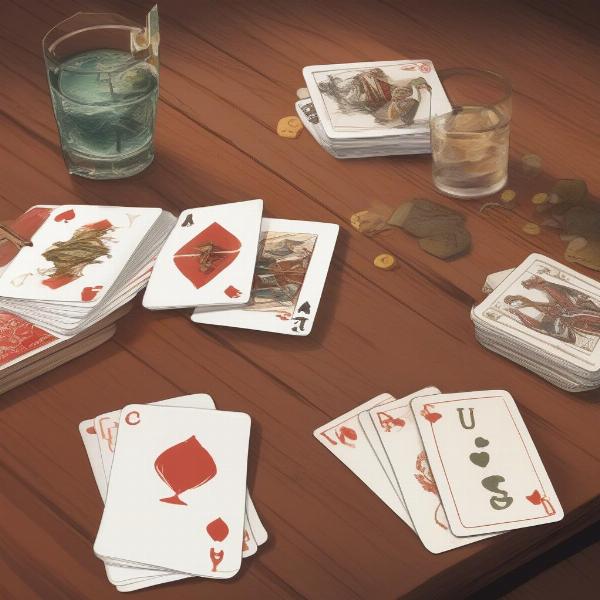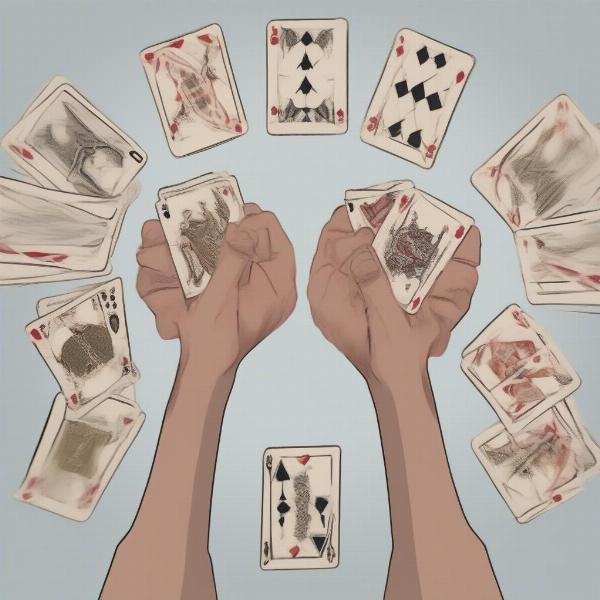Welcome to supremeduelist.blog, your go-to source for in-depth game analysis. Today, we’re diving into the fascinating world of card games, specifically focusing on three popular options: Bridge, War, and Gin. We’ll explore the mechanics of each game, delve into their strategic nuances, and offer comparisons to help you understand what makes each one unique.
This article will not only provide a comprehensive guide to these card games but also offer insights into their appeal and how they fit into the broader gaming landscape. Whether you’re a seasoned card player or a curious beginner, our detailed analysis will help you understand the strategy and enjoyment that each game offers.
Understanding the Basics of Bridge, War, and Gin
Before we dive deep into the tactics, it’s crucial to understand the core mechanics of each game. Bridge, War, and Gin are all played with a standard 52-card deck, but they differ significantly in their gameplay, objectives, and strategic depth.
Bridge: The Game of Skill and Partnership
Bridge is a trick-taking card game played by four players in two competing partnerships. The game involves two main phases: bidding and trick-taking. During the bidding phase, players communicate information about their hand strength and trump suit preferences through a series of bids. The highest bidder becomes the declarer, and their partner becomes the dummy. The declarer’s goal is to win a set number of tricks based on the contract determined during the bidding. Bridge is renowned for its strategic complexity, demanding both skillful card play and an understanding of bidding conventions.
War: The Game of Chance
War, in stark contrast to Bridge, is a simple game of pure chance, usually played between two players. Each player receives half of the deck, face down. Players simultaneously flip over the top card of their piles, and the player with the higher-ranking card wins both cards. If both cards have the same rank, a “war” ensues, involving additional card flips. The goal of War is to win all the cards in the deck. There’s minimal strategy involved, making it an ideal game for young children or those seeking a casual, uncomplicated experience.
 card-games-comparison
card-games-comparison
Gin: The Game of Strategy and Card Management
Gin, often referred to as Gin Rummy, is a two-player game that combines strategy and card management. The objective is to form sets or runs of cards and to reduce the deadwood (unmatched cards) in your hand. Players draw and discard cards, aiming to create the best hand possible before their opponent. Gin is popular because of its relatively quick gameplay and the balance between luck and skill. The strategy lies in deciding which cards to keep, which to discard, and when to “knock” to end the round.
Key Strategic Differences in Card Games
Each of these card games requires a different approach. Let’s explore the key strategic elements that sets them apart.
Strategic Depth in Bridge
Bridge is renowned for its significant strategic depth. The bidding process is a core element, requiring players to understand bidding conventions, analyze their hand strength, and communicate with their partners. The strategic use of signals is a key component as well. In the trick-taking phase, players must make calculated decisions about when to play specific cards, accounting for the cards that have already been played and the cards that their opponents are likely holding. According to expert bridge player, Dr. Eleanor Vance, “Bridge isn’t just about having the best hand, it’s about the effective use of information and making the right decisions based on available information”.
The Randomness of War
War offers essentially no strategic opportunities. Because it is based on pure luck, the outcome of the game is solely dependent on the shuffle of the deck. Players have no control over the cards they receive or the cards their opponents play. The game offers little in the way of learning and skill development as the players merely flip the top card on their deck and compare the value of the cards drawn. The simplicity is a significant part of the games attraction to its core audience.
Strategy and Observation in Gin
Gin requires a solid understanding of basic probability, deduction and observation. Players must constantly assess the chances of drawing specific cards while anticipating their opponent’s likely actions. Card management is critical. Keeping track of discarded cards and strategically deciding which cards to keep and which to discard can greatly impact their chances of winning. Expert game theorist, Professor James Carter, notes, “Gin is a careful balance between risk and reward. Deciding when to go for Gin versus taking the safe route of a knock is key to successful play”.
The Appeal of Each Game: Why People Play
Each game has its unique appeal. Understanding this is critical when deciding which one to engage in or recommend.
Bridge: The Mental Challenge
Bridge attracts players who enjoy a mental challenge, a game that requires critical thinking, deductive reasoning, and complex strategy. The social element of playing in partnerships also appeals to many players. The game is popular at bridge clubs and in online gaming communities, which means that you can play it at every level, from beginner to professional level.
War: The Simple Entertainment
War appeals to players who prefer a very simple and uncomplicated experience. It is a great game for younger children, as it does not require much skill. It’s also suitable for adults seeking casual, low-stakes entertainment that needs little focus. Its ease of play is a large part of its appeal.
 war-card-game-layout
war-card-game-layout
Gin: The Mix of Luck and Skill
Gin appeals to players who enjoy a mix of luck and skill. The game offers enough challenge to keep players engaged but not so much as to be intimidating. The relatively quick gameplay of Gin allows for multiple games in a single session, and many enjoy its social aspect. Gin is frequently played among families and friends at home.
How to Play: Brief Instructions
Here’s a brief overview of how to play each game:
How to Play Bridge
- Deal: Each of the four players receives 13 cards.
- Bidding: Players bid in turn, stating the number of tricks they think they can win and the trump suit (or no trump).
- Play: The declarer plays their hand, and their partner plays the “dummy” hand, which lies face-up on the table.
- Scoring: Points are awarded based on how many tricks are won compared to the contract bid.
How to Play War
- Deal: The deck is divided evenly between the two players.
- Play: Both players reveal their top card. The higher card wins both.
- War: If cards are the same rank, a “war” takes place, which involves multiple cards being drawn until a winner is decided.
- Winner: The player who wins all of the cards wins the game.
How to Play Gin
- Deal: Each player receives 10 cards.
- Turn: Players draw one card and discard one card.
- Form Sets/Runs: Players aim to make sets (cards of the same rank) and runs (consecutive cards of the same suit).
- Knock or Go Gin: Players either knock when they have a low number of deadwood points or go “Gin” when they have a melded hand.
- Scoring: Points are awarded based on the number of deadwood points left in each player’s hand.
Frequently Asked Questions
Here are some frequently asked questions related to the games we have discussed:
What is a “trick” in Bridge?
In Bridge, a “trick” is a round in which each player plays one card. The player who plays the highest-ranking card in the lead suit (or the highest trump card if trumps are in play) wins the trick.
What is the “war” in the game of War?
A “war” in War occurs when two players reveal cards of the same rank. In this case, both players place three additional cards face down, and then turn over one card face up to compare, with the player who has the higher rank card winning all of those cards.
What does “Gin” mean in Gin Rummy?
Going “Gin” in Gin Rummy means that a player has successfully melded all their cards, meaning there are no remaining deadwood points. This ends the round and typically earns the player a higher score.
What are the most important skills for playing card games?
Patience and observational skills are important for most card games, as well as deduction, probability and card management in the games with strategic elements, like Bridge and Gin.
What’s the best card game to start with for beginners?
For beginners, War is the simplest because it requires no skill or strategy. Gin is also suitable for beginners, as its rules are relatively easy to understand, and there’s a balance of luck and strategy. Bridge is generally considered to be complex and not suitable for beginners.
Conclusion: Choosing Your Card Game
Bridge, War, and Gin offer diverse experiences. Bridge provides complex strategic depth, War offers simplicity, and Gin combines strategy and luck. Depending on the player’s preferences and skill levels, each of these card games can provide many hours of fun and entertainment. At supremeduelist.blog, we aim to give you the insights needed to make informed choices when you choose the games that will bring you fun and excitement. Whether you’re seeking a mental challenge or simple entertainment, understanding the nuances of each game will enhance your overall experience.
We hope this detailed analysis has been helpful. Come back soon for more in-depth game analysis at supremeduelist.blog.
Leave a Reply